|
|
 |
|
Calanoida ( Order ) |
|
|
|
Diaptomoidea ( Superfamily ) |
|
|
|
Pontellidae ( Family ) |
|
|
|
Pontella ( Genus ) |
|
|
| |
Pontella karachiensis Fazal-Ur-Rehman, 1973 (F,M) | |
| | | | | | | Ref.: | | | Rehman, 1973 (p.151, figs.F,M); Silas & Pillai, 1973 (1976) (p.776); El-Sherbiny & Ueda, 2008 (p.11, Redescr.F,M, figs.F,M, Rem.); Manor & al., 2009 (p.2371, figs.: eye structure) | 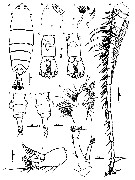 issued from : M.M. El-Sherbiny & H. Ueda in Plankton & Benthos Res., 2008, 3 (1). [p.12, Fig.2]. Female (from N Red Sea): A, habitus (dorsal); B, forehead (lateral); C-D, urosome (dorsal and ventral, respectively); E-F, urosome (right and left lateral, respectively); G, A1; H, A2; I, Md (cutting edge); J, Md (mandibular palp); K, Mx1. All scale bars in mm. Nota : Urosome 3-segmented. Genital compound somite asymmetrical, with small, slightly bi- or trilobed dorsolateral process on left side, large posterodorsal elevation directed posterodorsally and protrusion on right side ; genital operculum located distally without any processes. 2nd somite symmetrical and as long as genital compound somite. anal somite considerably shorter and narrower than 2nd urosomite. Caudal rami symmetrical, each ramus nearly 1.9 times as long as its maximum width. A1 24-segmented, with incomplete suture between ancestral segments XIII and XiV, not extending beyond 3rd pediger, with row of hairs on posterior surface from segments 2 to 12. A2 : coxa with plumose seta medially ; basis with 2 distomedial setae of unequal length ; exopod 5-segmented with setal formula 1, 3, 1, 2, 4 ; endopod with 2 setae on 1st segment, 6 long and 3 short setae on proximal lobe of 2nd segment, and 6 long and 1 median setae and row of posterior spinules on distal lobe of 2nd segment . Md : cutting edge bearing 7 teeth and 1spinulose seta ; palp basis bearing 5 setae ; exopod 5-segmented with setal formula 0, 1, 1, 1, 3 : endopod 2-segmented with 4 setae on 1st segment and 6 long and 2 short setae on 2nd segment. Mx1 : praecoxal arthrite carrying 15 setae on anda round distal margin ; coxal endite with 3 unequal apical stout setae ; coxal epipodite with 9 plumose setae ; basis with 1 long seta representing basal exite ; 1st and 2nd endites with 4 and 3 setae, respectively ; basis fused to endopod with 2 setae on each 1st and 2nd endopodal segments, respectively ; and 5 apical setae on distal segment ; exopod 1-segmented with 9 setae distally.
|
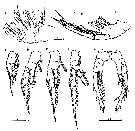 issued from : M.M. El-Sherbiny & H. Ueda in Plankton & Benthos Res., 2008, 3 (1). [p.13, Fig.3]. Female: A, Mx2; B, Mxp; C-G, P1 to P5. All scale bars in mm. Nota: Mx2: praecoxa and coxa fused; 1st and 2nd praecoxal endites with 5 and 3 setae, respectively; 1st and 2nd coxal endites each armed with 3 setae; basis carrying 1 long and 2 short setae; endopod with 6 long and 1 small setae. Mxp 7-segmented; syncoxal endites with setal formula 2, 3, 3 setae; basis medial margin fringed with row of stout teeth and bearing 2 setae distally; endopod 6-segmented, with 2 setae on 1st segment almost fused to basis, 2 setae distally on 2nd segment, 1 distal seta on 3rd to 5th segments, and 4 unequal setae each on distal segment.
|
 issued from : M.M. El-Sherbiny & H. Ueda in Plankton & Benthos Res., 2008, 3 (1). [p.15, Fig.5]. Female: A-D, variation in shape of genital compound somite. All scale bars in mm. Nota: The dorsolateral process on left side and dorsal projection of genital compound somite vary in shape among individuals
|
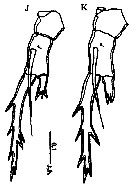 issued from : M.M. El-Sherbiny & H. Ueda in Plankton & Benthos Res., 2008, 3 (1). [p.14, Fig.4, J-K]. Female: J-K, variation of left P5. Left P5 varies among individuals; some specimens have trifurcated endopod and/or exopod with 2 processes on medial margin.
|
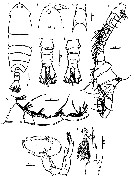 issued from : M.M. El-Sherbiny & H. Ueda in Plankton & Benthos Res., 2008, 3 (1). [p.14, Fig.4, A-I]. Male: A, habitus (dorsal); B, forehead (lateral); C, rostrum (frontal view); D-E, urosome (dorsal and ventral, respectively); ; F, right A1; G, geniculate part of right A1; H, P5 (posterior); I, 2nd exopodal segment of left P5 (posterior). Nota: Rostrum bifid; bulbous with 2 lenses. Urosome 5-segmented. Genital somite asymmetrical with 2 sensilla on each side; left side weakly swollen with genital aperture located ventrolaterally at posterior rim; nd urosomite with 2 dorsal sensilla on each side; 3rd urosomite longer than following 2 somites combined. Caudal rami symmetrical and about 1.9 times as long as its maximum width. Right A1 geniculated, 20-segmented, extending to middle of 3rd pediger; segments 5-6 and 9-11 partly fused; segment 13 (XIV) with long modified spine; anterior margin of segment 16 (XVII) with coarse-lamellate plate extending to segment 15; segment 17 (XVIII) with 2 plates carrying acuminate sharp teeth; fused segment 18 (XIX-XXI) with spur-like strong process fused at base distally and 2 toothed plates; proximal plate with sharp elevated acuminate teeth and distal one with lamelliform teeth. Left A1 as in female. Number of sensilla on 1st and 2nd urosomites differs among individuals.
|
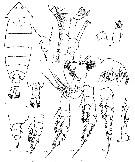 issued from : Fazal-Ur-Rehman in Crustaceana, 1973, 24 (2). [p.152, Figs.1-15]. Female (from Manora Channel, W Pakistan): 1, habitus (dorsal); 2, urosome (ventral); 3-4, urosome (lateral, right and left, respectively); 5, right A1; 6, right A2; 7, Md (cutting edge); 7a, Md (mandibular palp); 8, Mx1; 9, Mx2; 10, Mxp; 11, right P1; 12, right P2; 13, right P3; 14, right P4; 15, P5. Nota : Cephalosome provided with a distinct lateral hook on each side. One cuticular lens present on either side of the head. Rostrum bifid, provided with a distinct rostral lens. A ventral eye present. Lateral angle of the 5th thoracic somite in dorsal view is slightly flexed posteriorly, somewhat rounded in shape and provided with a minute spine on each side. Urosome asymmetrical, 2-segmented ; the 1st segment is provided with a distinct suture which may indicate fusion of several somites. A distinct mid-dorsal outgrowth projects posteriorly near the middle of the genital segment ; a lateral outgrowth, slightly bifid in shape present anteriorly on the left side of the mid-dorsal region ; genital orifice bounded by 2 bulb-like protuberances, the anterior being larger than the posterior. Anal segment small. Caudal rami symmetrical, on each carry 5 plumose setae and 1 small sensory bristle, located between the 1st and 2nd seta from the inner margin. A1 24-segmented, does not extend beyond the 2nd thoracic somite. A2 endopod longer than exopod, 2-segmented with the 1st segment nearly 3 times as long as 2nd ( 2 setae present on the inner side and 13 at the terminal and subterminal ends) ; exopod 5-segmented, the 2nd being longer than all others. Md with a well developed cutting edge on the masticatory process (6 teeth and a plumose seta) ; mandibular palp with a large basal segment ; exopod 4-segmented ; endopod 2-segmented. Mx1 with the 1st inner lobe (gnathobase) carries 13 strong spines arranged in double rows ; 2nd and 3rd inner lobes with 3 setae on each lobe, outer one (coxal epipodite) with 9 long setae ; exopod and endopod bear in all 20 setae.
|
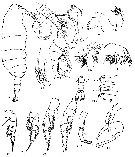 issued from : Fazal-Ur-Rehman in Crustaceana, 1973, 24 (2). [p.154, Figs.16-28]. Male: 16, habitus (lateral); 17, right A1; 18, right A2; 19, Md (cutting edge); 19a, Md (mandibular palp); 20, Mx1; 21, Mx2; 22, Mxp; 23, right P1; 24, right P2; 25, right P3; 26, right P4; 27a, left P5; 27b, right P5; 27c-d-e, magnified tip drawn at different angles; 28, urosome (dorsal). Nota : Urosome 5-segmented and symmetrical. Right A1 geniculated with the flexion situated between th 18th and 19th segment ; an elongated ridge present on segment 17, extending to segment 16, an dis provided with annulations proximally and fine denticles distally ; a similar but smaller ridge is present on segment 18 butoverlaps the distal portio of the ridge present on segment 17, it is provided with a single row of large spiniform denticles ; the segmentation of the distal segments is indistinct.
|
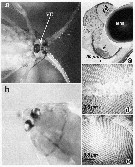 issued from : S. Manor, O. Polak, W.M. Saidel, T.L. Goulet & N. Shashar in Vision Res., 2009, 49. [p.2372, Fig.1]. a, forehead with vental eye (VE); b, dorsal eye: courtesy of Dr. Viviana Farstey. c, cross section in the dorsal eye showing the lower lens, the two retina cups and location of the photoreceptors (arrows); ac, images taken from female, though should be similar with males. Higher magnification. d, shows the microvilli of each photoreceptor aligned parallel to each other, and perpendicular to microvilli of neighboring cells. e, an oblique section of another pair of cells in which microvilli are aligned at different orientations, providing an anatomical basis for polarization sensitivity.
|
 issued from : M. I. Palet in J. mar. biol. Ass. India, 1975, 17 (3). [p.661, Fig.1]. Female (from off Dwarka, NW India): a, habitus (lateral); b, right A1; c, P5. Male: d, habitus (lateral); e, right A1; f, left P5; g, right P5. Nota Female: Length ratio of cephalothorax and urosome 62 : 39. Abdomen 2-segmented, asymmetrical; proportional lengths of urosomal segments and caudal ramus 27 : 22 : 51 = 100. Nota Male: Proportional length of cephalothorax and urosome 55 : 34. Abdomen 5-segmented, symmetrical; proportional lengths of urosomal segments and caudal ramus 18 : 15 : 19 : 12 : 10 : 26 = 100. Left A1 unmodified 24-segmented; geniculation of right A1 situated between 18th and 19th segments, 17th segment bears an elongated ridge, with annulations proximally and fine denticles distally, extending to segment 16; 18th segment armed with a similar but smaller ridge, carrying a single row of large spiniform denticles; segmentation of 20th segment indistinct.
| | | | | Compl. Ref.: | | | Patel, 1975 (p.660); Grice & Gibson, 1978 (p.23, tab.8); Sharaf & Al-Ghais, 1997 (tab.1); El-Serehy, 1999 (p.172, Table 1, occurrence); Kazmi, 2004 (p.229, Rem.: p.232) | | | | NZ: | 2 | | |
|
Distribution map of Pontella karachiensis by geographical zones
|
| | | | | | | Loc: | | | Arabian Sea (Karachi), Arabian Gulf (UAE coast); Manora Channel, India (Saurashtra coast), Arabian Gulf, N Red Sea | | | | N: | 8 | | | | Lg.: | | | (271) F: 4,2-4,1; M: 3,7; (1039) F: 3,4-4,4; M: 3,2-3,9; (1079) F: 5,03; M: 4,08; {F: 3,40-5,03; M: 3,20-4,08} | | | | Rem.: | epipelagic
After Fazal-Ur-Rehman (1973, p.155) tis species resembles Pontella mimocerami
Fleminger (1957).El-Sherbiny & Ueda (2008, p.16) establish the karachiensis group.
For Kazmi (2004, p.232) this species does not longer considerd endemic to Karachi. Its range now extends to India. | | | Last update : 21/07/2016 | |
|
|
 Any use of this site for a publication will be mentioned with the following reference : Any use of this site for a publication will be mentioned with the following reference :
Razouls C., Desreumaux N., Kouwenberg J. and de Bovée F., 2005-2025. - Biodiversity of Marine Planktonic Copepods (morphology, geographical distribution and biological data). Sorbonne University, CNRS. Available at http://copepodes.obs-banyuls.fr/en [Accessed November 29, 2025] © copyright 2005-2025 Sorbonne University, CNRS
|
|
 |
 |











